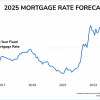
Cash-out refinance rates are 0.25% to 0.50% higher than rate-and-term (no-cash) refinance rates.
This assumes an excellent credit score and 75% loan-to-value (LTV), meaning 25% equity remains in the home after the cash is taken.
So if you could get a standard refinance at 6%, a cash-out loan might be 6.25% to 6.5%.
However, your cash-out rate could be nearly identical to a no-cash refi – or 1-2% higher. It depends on your credit score, loan-to-value (LTV), and property type.
Here’s how to get low cash-out refinance rates.
Low Cash-Out Mortgage Rates
Fannie Mae and Freddie Mac – where most cash-out loans come from – mandate that lenders apply risk-based pricing to these loans.
The best cash-out rates are for these borrowers:
Credit scores above 720
25% equity remaining after the refinance
Financing a primary residence rather than a second home or investment property
Financing a single-family (1-unit) house or townhome
Seeking a loan under the current conforming loan limits
You could be eligible for cash-out at terms other than the above, but rates will be higher.
The following are estimated rate increases for each loan attribute. Keep in mind that these could vary by lender and even by day, depending on the mortgage market at the time.
Credit score
This is where your rate will vary the most. Conventional rates – especially cash-out ones – are extremely sensitive to credit scores. Here’s how much higher cash-out rates might be compared to no-cash refinance rates.
760+: +0.125% to 0.375% higher than no-cash refi rates
720-759: +0.25% to 0.50%
680-719: +0.25% to 0.75%
660-679: +0.75% to 1.0%
620-659: +1.0 to 1.5%
Following are additional features that could make your rate even higher than these credit score add-ons. All rate increases are cumulative.
Home Type
Here’s how much higher your cash-out refinance rate might be compared to a cash-out refi on a standard single-family home.
Condo: +0% to 0.125% higher than single-family cash-out
Manufactured home: +0.25 to 0.375%
2-4 unit: +0.125 to 0.25%
Property Use
Primary residences will receive the lowest cash-out refinance rates.
Second home: +0.75 to 1.5% higher than primary residence cash-out
Investment property: +0.75 to 1.5%
Loan Amount
Loans over the standard conventional limit will receive higher rates.
Fixed loans exceeding the conventional limit: +0.75 to 1.5% higher rate
Adjustable-rate loans exceeding the conventional limit: +1.0% to 1.75%
Why It’s Hard to Pinpoint Cash-Out Rates (For Nerds Only)
Read this section only if you’re really interested in mortgage rate pricing.
Most lenders price cash-out refinance loans based on Fannie Mae and Freddie Mac standards. These are the two rule-making agencies for most loans in the U.S.
Fannie Mae and Freddie Mac publish add-ons to fees, not rates. This method makes it impossible to say how much higher your cash-out rate might be compared to no-cash refi rates.
Most borrowers choose to absorb fee increases with a higher rate. But how much of a rate increase is required changes daily with the market.
For example, you have a 700 credit score and want a cash-out refinance at 75% LTV. This requires an extra fee (not rate increase) of 1.375% of the loan amount. For a $300,000 loan, that’s $4,125.
Few people want to pay an extra $4,125 out of pocket. Instead, they take a rate that’s about 0.25% to 0.75% higher. But every day, the rate increase required to absorb this fee changes.
The rate bump can be substantial under some mortgage market conditions. As of this writing, we have an illiquid mortgage market. This means the end investor is not willing to pay a premium for higher loan rates. (Read why here.)
You may have to pay points and take a rate that’s 1.5% to 2% higher than typical market rates just to have access to certain combinations of loan features like cash-out, investment property financing, and condo loans.
No matter what loan you get, your final rate is determined by indirect means. Your lender is probably not trying to hide anything by not explaining it all; they do it to save you the headache of understanding the complex world of loan pricing.
Do All Lenders Require These Add-Ons?
Most lenders adhere to Fannie Mae and Freddie Mac rates and guidelines for cash-out loans. But some offer their own programs.
For example, many lenders create jumbo loan programs. They may even offer lower rates for high loan amounts, second homes, and loans with other risk factors that Fannie and Freddie must account for.
It’s worth shopping around with many lenders. Ask if they offer cash-out programs outside of Fannie Mae and Freddie Mac guidelines and get quotes for both.
Get a Rate Quote
The best way to know what your rate will be is to get a quote on the same scenario from two or three lenders. One could prove to be the obvious winner for your cash-out refinance.




